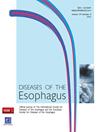450. TISSUE RESIDENT MEMORY CELLS: CORRELATING THE PHENOTYPIC AND FUNCTIONAL CAPABILITIES OF A POTENTIAL TUMOUR REACTIVE CELL POPULATION IN OESOPHAGEAL ADENOCARCINOMA
IF 2.3
3区 医学
Q3 GASTROENTEROLOGY & HEPATOLOGY
引用次数: 0
Abstract
Background Oesophageal adenocarcinoma (OAC) is a disease with a high mortality and morbidity rate. Immunotherapy has recently demonstrated progress in the treatment of OAC but its impact on long term survival is currently uncertain. Tissue resident memory (TRM) T cells are a subset of lymphocytes within the tumour/tissue infiltrating lymphocyte (TIL) milieu that has attracted considerable interest within cancer immunology. Although TRM cells have been associated with better outcomes in multiple cancer types there is a lack of knowledge of their role in OAC. This study aims to critically correlate the phenotype of TRM with their functional capacity in this disease. Methods 33 patients undergoing surgical resection for OAC were recruited and consented for collection of fresh tumour (T), adjacent normal tissue (AN), and peripheral blood. Peripheral blood mononuclear cell (PBMC) from blood and infiltrating lymphocytes from T and AN were isolated using standard density gradient and enzymatic digestion protocols. Multiparametric flow cytometry was performed on 12 patients using matched PBMC, T and AN infiltrating lymphocytes for phenotypic analysis and 21 patients for functional analysis following cell stimulation assay. BD FACSymphony was used for data acquisition and data analysed on FlowJo version 10.10. Statistical analysis was carried out using GraphPad Prism. Results TRM (CD103+CD69+) dominated the CD8+ T cell population of T and AN TIL. Expression of checkpoint proteins PD1+ and CD39+, a marker of tumour reactivity, was identified on CD8+ TRM and CD8+ non TRM in TIL. The differentiation status of TRM within memory lineages demonstrated that TRM express a higher proportion of effector memory cells (CCR7-CD45RA) compared to those in blood. TRM cells also showed lower expression of the transcription factors EOMES, TBET and TCF compared to CD8+ cells within PBMC. Moreover, tumour CD8+ TRM populations had reduced ability to produce IL-2 following stimulation compared to adjacent normal TRM populations. Conclusion TRM make up a large proportion of CD8+ T cell within the tumour microenvironment (TME) of OAC. TRM generation is associated with the downregulation of T-Box transcription factors EOMES and TBET and expression of an effector memory phenotype with reduction of the stem-like transcription factor, TCF. High levels of CD39+ indicate a strong level of activation but the increased PD1 expression and reduced capability to produce IL2 indicate functional impairment suppressed within the TME. An opportunity may exist to reverse this with novel immunotherapeutic agents.450.组织常驻记忆细胞:食管腺癌潜在肿瘤反应细胞群的表型和功能相关性
背景 食管腺癌(OAC)是一种死亡率和发病率都很高的疾病。免疫疗法最近在治疗食管腺癌方面取得了进展,但其对长期生存的影响目前尚不确定。组织驻留记忆(TRM)T细胞是肿瘤/组织浸润淋巴细胞(TIL)环境中的一个淋巴细胞亚群,在癌症免疫学领域引起了广泛关注。尽管TRM细胞与多种癌症类型的较佳预后有关,但人们对其在OAC中的作用还缺乏了解。本研究旨在将 TRM 的表型与它们在这种疾病中的功能能力密切联系起来。方法:招募 33 名因 OAC 而接受手术切除的患者,同意收集新鲜肿瘤(T)、邻近正常组织(AN)和外周血。采用标准密度梯度和酶解方案分离血液中的外周血单核细胞(PBMC)以及肿瘤和正常组织中的浸润淋巴细胞。使用匹配的外周血单核细胞、T淋巴细胞和AN浸润淋巴细胞对12名患者进行多参数流式细胞术表型分析,并在细胞刺激试验后对21名患者进行功能分析。数据采集使用 BD FACSymphony,数据分析使用 FlowJo 10.10 版。使用 GraphPad Prism 进行统计分析。结果 TRM(CD103+CD69+)在T和AN TIL的CD8+T细胞群中占主导地位。在TIL的CD8+ TRM和CD8+非TRM上发现了检查点蛋白PD1+和CD39+(肿瘤反应性标记物)的表达。TRM在记忆系中的分化状态表明,与血液中的TRM相比,TRM表达的效应记忆细胞(CCR7-CD45RA)比例更高。与 PBMC 中的 CD8+ 细胞相比,TRM 细胞表达的转录因子 EOMES、TBET 和 TCF 也较低。此外,与邻近的正常 TRM 群体相比,肿瘤 CD8+ TRM 群体在受到刺激后产生 IL-2 的能力降低。结论 在 OAC 的肿瘤微环境(TME)中,TRM 占 CD8+ T 细胞的很大比例。TRM的产生与T-Box转录因子EOMES和TBET的下调以及效应记忆表型的表达和干样转录因子TCF的减少有关。高水平的 CD39+ 表明活化水平很高,但 PD1 表达的增加和产生 IL2 能力的降低表明在 TME 内受到抑制的功能损伤。新型免疫治疗药物可能有机会扭转这一局面。
本文章由计算机程序翻译,如有差异,请以英文原文为准。
求助全文
约1分钟内获得全文
求助全文
来源期刊

Diseases of the Esophagus
医学-胃肠肝病学
CiteScore
5.30
自引率
7.70%
发文量
568
审稿时长
6 months
期刊介绍:
Diseases of the Esophagus covers all aspects of the esophagus - etiology, investigation and diagnosis, and both medical and surgical treatment.
 求助内容:
求助内容: 应助结果提醒方式:
应助结果提醒方式:


